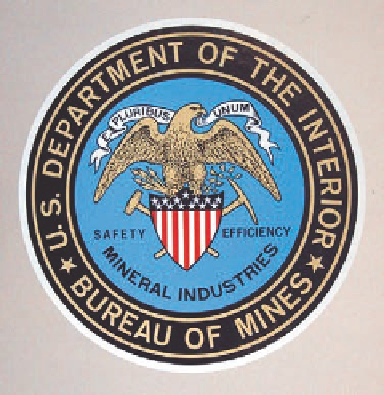Geology Reference
In-Depth Information
16.1. United States Bureau of
Mines
Ann G. Kim
Emblem of the US Department of Interior,
Bureau of Mines (1910-1996).
Introduction
T
he United States (US) Bureau of Mines was created by Act of Congress in 1910 as a part of the Department of
Interior. Its primary mission was to reduce the number of fatalities due to coal mining accidents, particularly fires
and explosions. In 1913, its roll was expanded to the collection, analysis and dissemination of economic data
related to mining. The Coal Mine Inspection Act of 1941 gave the Bureau the right to inspect mines for safety
conditions and to recommend corrective actions. Enforcement power was limited until the Federal Coal Mine
Health and Safety Act of 1969 established mandatory standards.
Since its inception, the Bureau was a research organization developing solutions to a variety of mining related
problems, including safer explosives, ignition suppression devices, subsidence control, methane drainage, and
mined land reclamation. The Bureau of Mines was recognized nationally and internationally as a source of
mining and mineral information and for its mining and environmental research. Over the 86 years of its
existence, the Bureau had a significant impact on reducing the number of mining related fatalities (Figure 16.1.1).
In 1996, the Bureau of Mines was closed by Congress. Although some of its programs were transferred to
other federal agencies, most of its research programs ended. According to Rhea Graham, the last Director of
the Bureau of Mines, the accomplishments of this agency had made a difference. Its legacy remains in the
hundreds of Reports of Investigations, Information Circulars, Bulletins, and other publications that documented
its work.
Mine-Fire Control
A
lthough the Bureau had an extensive program on suppressing and controlling fires in active mines, this report
focuses on their work on coal fires in inactive or abandoned mines and waste banks. When the Bureau of Mines
was established, its role in inactive coal-mine fires was limited to investigation and providing advice on controlling
them. In 1948, Congress expanded the Bureau
s function to controlling fires on Federal land and providing
technical and financial assistance for the control of fires on non-Federal lands. Research on the causes and control
or extinguishment of fires in outcrops and underground coal formations was also authorized (Griffith et al., 1960).
In 1964, the Appalachian Regional Development Act allowed the Bureau to actively participate in controlling fires
in abandoned mines in the Appalachian region.
'
Under the Surface Mining Control and Reclamation Act (SMCRA) of 1977, the Abandoned Mined Land (AML)
Program was transferred to the Office of Surface Mining, Reclamation, and Enforcement (OSM). Surface and
underground fires were categories in OSM
s Inventory of AML problems. Fire-control projects were handled by
OSM or by states with approved mining reclamation programs. The law also provided for research on mining
'





